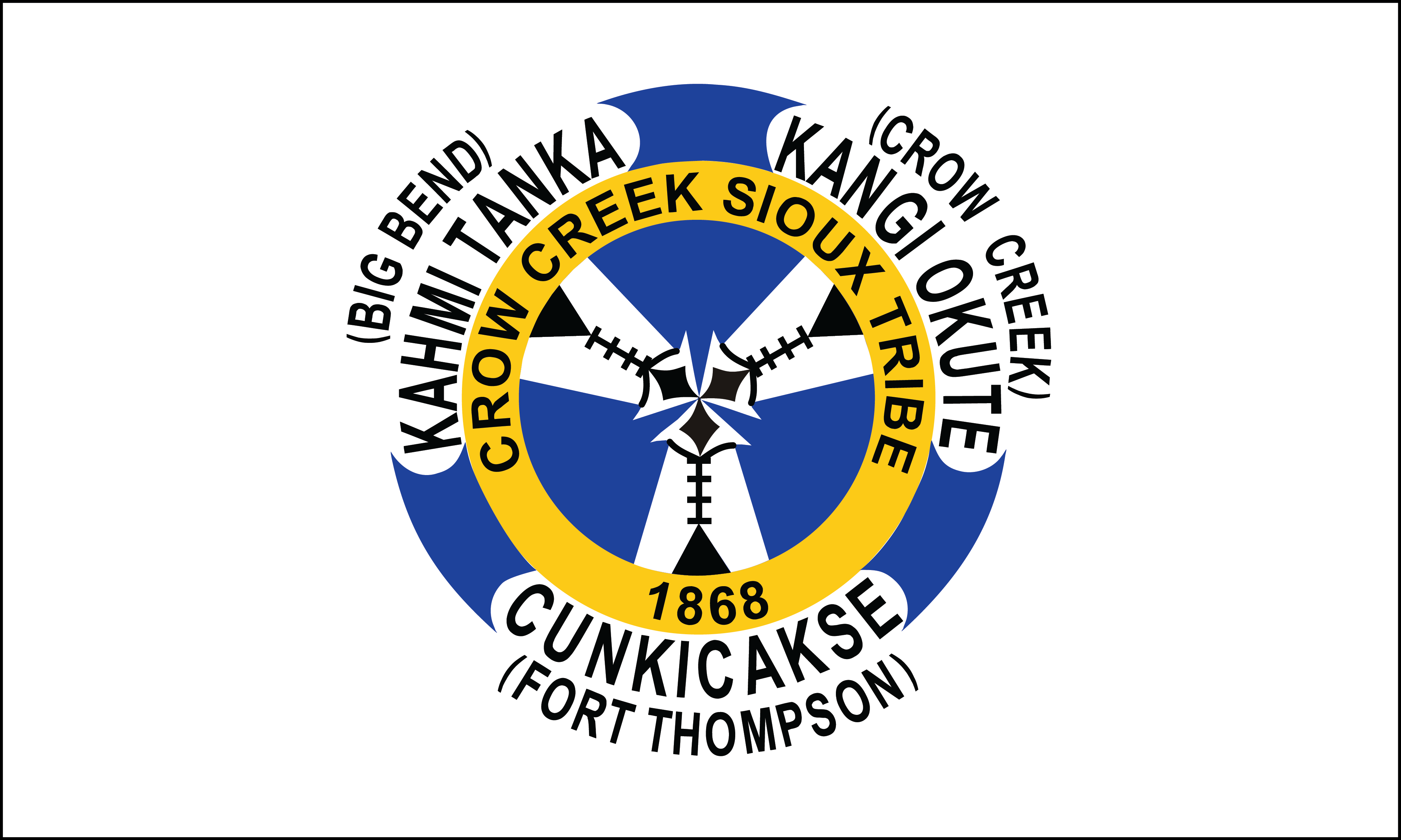
The flag of the Crow Creek Sioux Tribe.
CAIRNS ETANHAN WOTANIN
By Center for American Indian Research and Native Studies
For The Lakota Country Times
lakotacountrytimes.com This week we continue our examination of the nine flags of nations with reservation lands in South Dakota. Last week we evaluated the Flandreau Santee Sioux Tribe flag and awarded its design 2 out of 5 stars. Now let’s see how the flag of the Crow Creek Sioux Tribe rates! Remember, flag designs can earn up to one star for each of the five principles of good flag design identified by Ted Kaye in his pamphlet, Good Flag, Bad Flag: How to Design a Great Flag. They are 1) keep it simple, 2) make it meaningful, 3) use 2-3 colors, 4) avoid numbers and letters, and 5) be distinctive. So with that in mind, let’s take a look at the Crow Creek Sioux Tribe flag. The flag is white with a medium blue circle at its center. Equally spaced around the inside of this circle are three white tipis accented in black to illustrate their triangular doors, lacing pins and smoke flaps. Their tops touch at the center of the circle. A yellow band surrounding the blue circle contains the words “Crow Creek Sioux Tribe” printed in black and centered across the top, and “1868,” also in black, centered at the bottom. The three districts of the Lower Brule Reservation—Kahmi Tanka, Kangi Okute and Cunkicakse—printed in black, are spaced around the outside edge of the yellow ring. The district names are divided into thirds by medium blue inserts. The English translations of the districts, Big Bend, Crow Creek and Fort Thompson respectively, appear in parentheses and in smaller letters centered above the district names. Now that we’ve taken a good look at the flag, let’s see how it rates according to the five principles of good flag design. Right away we can see that, due to the amount of writing incorporated into and around it, the flag’s otherwise simple central element becomes a rather complex carousel of pen strokes at first glance. Thus no star is gained for simplicity. For meaningfulness, a half star is awarded; other than a brief reference to the 1868 Fort Laramie Treaty, the only other element represented on the flag seems to be the reservation’s three districts. The flag scores a full star for its restrained use of color. However, it obviously gains no star for avoidance of lettering or numbers. For the last criterion, distinctiveness, the flag picks up one more star. Take away all the words and the three-pronged design with tipis pointing inward makes quite the eye-catching design. Again, it’s a shame that so many tribal flags overemphasize words and numbers, because the more visual elements of these flags often can stand on their own. Counting up the final tally, the Crow Creek Sioux Tribe flag earns 2.5 out of 5 stars. This is the same score that the flag of the Standing Rock Sioux Tribe – which also uses a central, circular logo on its flag – garnered a few weeks ago. So with one more flag to evaluate, our scoreboard reads as follows: Flandreau Santee Sioux and Cheyenne River Sioux tribes at 2 stars, Crow Creek Sioux and Standing Rock Sioux tribes at 2.5 stars, Sisseton Wahpeton Oyate and Rosebud Sioux Tribe at 3 stars, Yankton Sioux Tribe at 3.5 stars, and Oglala Sioux Tribe at 4.5 stars. Next week we’ll take a look at the ninth and final flag of nations with reservation lands in South Dakota: the flag of the Lower Brule Sioux Tribe! (The Center for American Indian Research and Native Studies (CAIRNS), based in Martin, South Dakota, is an Indian-controlled nonprofit research and education center that is committed to advancing knowledge and understanding of American Indian communities and issues important to them by developing quality educational resources and innovative projects that acknowledge and incorporate tribal perspectives, and by serving as a meeting ground for peoples and ideas that support those perspectives.) Find the award-winning Lakota Country Times on the Internet, Facebook and Twitter and download the new Lakota Country Times app today.
Join the Conversation
Related Stories
CAIRNS
Column: Examining Flandreau Santee Sioux Tribe's flag (10/28) CAIRNS Column: Examining the Standing Rock Sioux Tribe flag (10/14)
CAIRNS Column: Examining the flag from the Oglala Sioux Tribe (10/5)
CAIRNS Column: Examining the flag of the Rosebud Sioux Tribe (09/19)
CAIRNS Column: Examining the flag of the Yankton Sioux Tribe (09/09)
